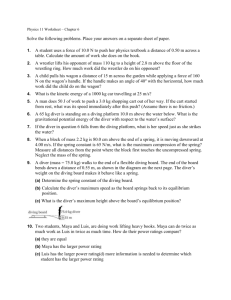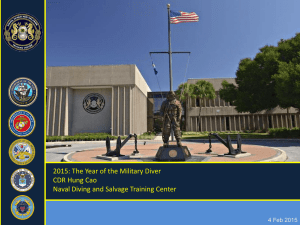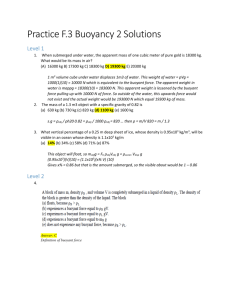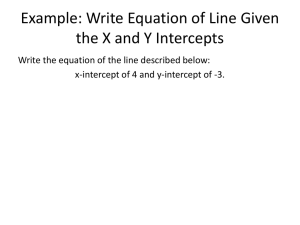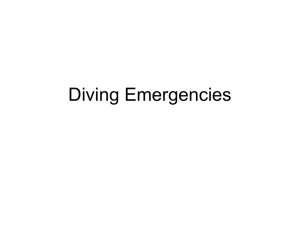Lipa Scuba Diving Physics Draft 3
advertisement
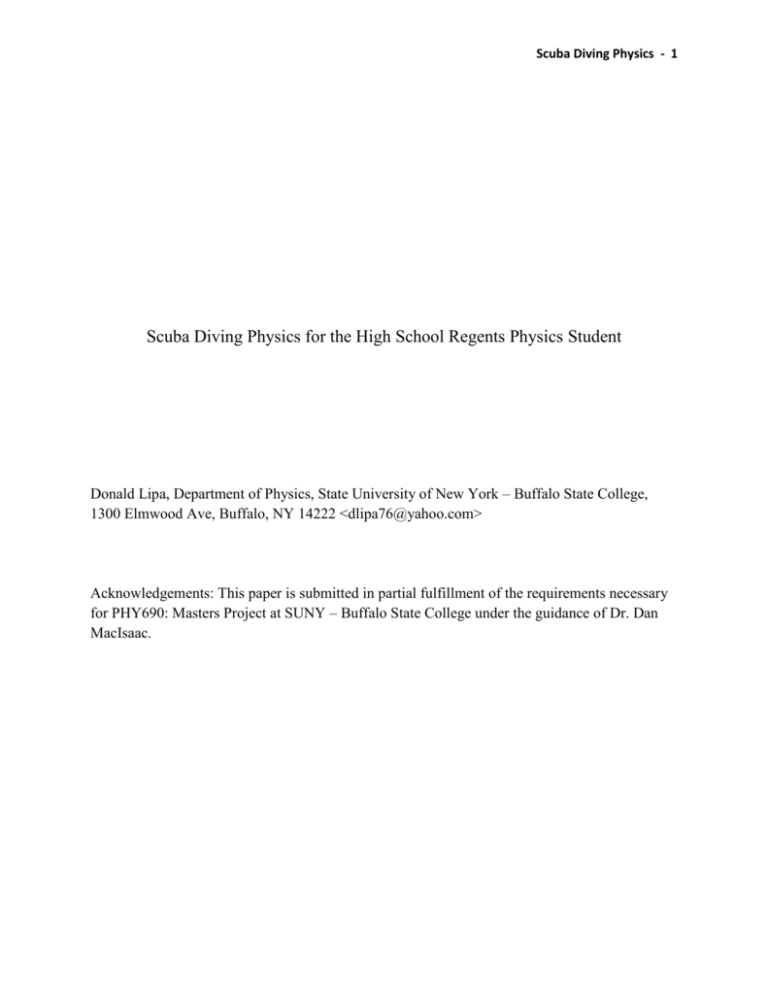
Scuba Diving Physics - 1 Scuba Diving Physics for the High School Regents Physics Student Donald Lipa, Department of Physics, State University of New York – Buffalo State College, 1300 Elmwood Ave, Buffalo, NY 14222 <dlipa76@yahoo.com> Acknowledgements: This paper is submitted in partial fulfillment of the requirements necessary for PHY690: Masters Project at SUNY – Buffalo State College under the guidance of Dr. Dan MacIsaac. Scuba Diving Physics - 2 Abstract: This paper presents a collection of physics problems relating to the physics of scuba diving. Topics covered include Archimedes Principle, Boyle’s Law, Conservation of Momentum and Conservation of Energy. These problems sets were designed to be used as supplemental learning problems to be used alongside the Modeling curriculum worksheets. The goal of these problems is to get students critically thinking about and discussing the physics involved in a real world activity. These difficulty and vocabulary of these problems are geared toward the Regents Physics level though student. Biography: Donald Lipa lives in Capital Region of New York. He received a B.S. in Chemistry from SUNY Geneseo and a B.S. in Chemical Engineering from Columbia University in 1999. He began his career as a technology consultant working in the financial industry. In 2011 he received his certification in chemistry and physics and began his teaching career. Also in 2011 he began to work towards receiving his Masters Degree in Physics Education which culminated in this project. He is currently a regents physics teacher at Queensbury High School in Queensbury NY. Scuba Diving Physics - 3 Introduction: Teachers are always looking for new ways to engage students especially in the Regents Physics classroom where students are learning a broad swath of topics in rapid fire succession. Carefully crafted demos with the flair for dramatics are one way for students to be engaged. Another way to hook students is to show them how physics relates to real world activities. Scuba diving is one such activity that offers a rich diversity of physical phenomena that can be weaved into the overall Regents Physics curriculum. The phenomena covered in these series of problems include topics within the Regents Physics core curriculum, conservation of momentum and energy, but also contains topics outside the curriculum, Archimedes Principle and Boyle’s law. The question may arise, why cover topics outside of the curriculum? The author feels that these topics offer a good opportunity to enrich the student’s understanding of the physical world they live in and when the questions are carefully crafted, other related topics that are in the curriculum can be tied in, such as forces and proportional reasoning. Scuba Diving Phenomena and the New York State Physics Curriculum: The following table (Table 1) summarizes the standards that relate to these exercises in the New York State Physics Core Curriculum. Table 1: Standard 1 Analysis, Inquiry, and Design Mathematical Analysis: Key Idea 1: Abstraction and symbolic representation are used to communicate mathematically. o Manipulate equations to solve for unknowns. o Use dimensional analysis to confirm algebraic solutions Key Idea 3: Critical thinking skills are used in the solution of mathematical problems. o Apply algebraic and geometric concepts and skills to the solution of problems Standard 4 The Physical Setting Scuba Diving Physics - 4 Key Idea 4: Energy exists in many forms, and when these forms change energy is conserved. o 4.1 Observe and describe transmission of various forms of energy. o Observe and explain energy conversions in real-world situations Key Idea 5: Energy and matter interact through forces that result in changes in motion. o 5.1 Explain and predict different patterns of motion of objects (e.g., linear and uniform circular motion, velocity and acceleration, momentum and inertia). o Verify conservation of momentum The following table (Table 2) summarizes the various performance indicators that relate to these exercises. Table 2: Performance Indicators Performance Indicator 4.1: Students can observe and describe transmission of various forms of energy Major Understandings: o All energy transfers are governed by the law of conservation of energy. o All energy transfers are governed by the law of conservation of energy. o Potential energy is the energy an object possesses by virtue of its position or condition. Types of potential energy include gravitational and elastic o Kinetic energy is the energy an object possesses by virtue of its motion. o When work is done on or by a system, there is a change in the total energy of the o system o Work done against friction results in an increase in the internal energy of the system. Performance Indicator 5.1: Students can explain and predict different patterns of motion of objects (e.g., linear and uniform circular motion, velocity and acceleration, momentum and inertia). Major Understandings: o The impulse imparted to an object causes a change in its momentum o According to Newton’s Third Law, forces occur in action/reaction pairs. When one object exerts a force on a second, the second exerts a force on the first that is equal in magnitude and opposite in direction o Momentum is conserved in a closed system Scuba Diving Physics - 5 Background: Physics students feel that physics is hard subject with an intense workload but also very interesting. Students also see physics as theoretical and abstract but related to the real world (Angell, Guttersrud and Henriksen, 2004). The more physics teachers can relate the curriculum to everyday experience there will be greater student engagement and the more learning will take place. It is not surprising then physics teachers try whenever possible try to relate the material taught to the students in interesting and relevant ways. Recreational scuba diving is a sport that is not only interesting and engaging to students but also offers a wide array of physical phenomena that is relative to the high school physics curriculum. Scuba diving is unique also because it offers topics as simple as buoyancy to very complicated momentum and energy conservation concepts. The material can easily be tailored to any level course from a general physics class up to AP physics. This series of worksheets is designed as a mini unit in the physics modeling curriculum and is designed to be used with student whiteboarding circles. For more information on modeling please see the American Modeling Teachers Association (AMTA) at http://modelinginstruction.org/. This material is designed to be presented after the unit on momentum and provides a chance to spiral back on some topics and reinforce certain methods such as proportional reasoning. According to Arons (1996) spiraling back to re-encounter important ideas in a more sophisticated manner is critical in an introductory physics course. Other modeling tools the students have learned throughout the curriculum are also reinforced such as proportional reasoning, writing mathematical expressions to describe physical phenomena, energy pie charts and qualitative energy bar diagrams. Scuba Diving Physics - 6 Topic 1: Boyle’s Law: Boyle’s Law is a topic that should be familiar to all Regents Physics students as it is part of the Regents Chemistry core curriculum. These Boyles Law questions focus on proportional reasoning skills and dimensional analysis as it is a skill critical for the regents physics student to master. According to Arons students at the secondary level struggle to master reasoning involving ratios (1996) and these questions are designed to help reinforce that skill. There are many good online videos that demonstrate Boyle’s Law. Once such video, which served as inspiration for the author of this paper, was made by Dr. Jordan Gerton from the University of Utah while he was on vacation and can be found at https://www.youtube.com/watch?v=Alj1y2fQ1U. The Boyles law questions start with a simple proportional reasoning problem where the student is asked the weight in pounds of 1 in3 of water. The problem can be solved as follows: The following question asks how many feet of water would be needed to increase the pressure by 1 atm. The students are given that 1 atm = 14.7 lb/in3. This reinforces the concept that pressure in psi can be imagined as the weight of a rectangular column of water that has a cross sectional area of 1 in2. This can be drawn out on a whiteboard to illustrate the concept during the whiteboarding session. The problem can be easily solved using clever proportional reasoning as follows: Scuba Diving Physics - 7 Question 3 checks the students for understanding that at 33 ft. the pressure has increased by 1 atm but the total pressure including the atmospheric pressure is 2 atm. This is called absolute pressure and differs from gauge pressure (which would be 1 atm at 33 ft.). Question 4 contains some basic Boyle’s Law calculations where the students will use the formula to calculate the volume of a 1 L bubble released at 99 ft. (4 atm) as it rises at 66 ft., 33 ft., and right as the bubble reaches the surface (3 atm, 2 atm and 1 atm respectively). Question 5 is another Boyle’s Law question but requires the student to calculate the pressure at 75 ft before the gas law calculation using proportional reasoning. Setting Adding 1 atm to the gauge pressure will yield absolute pressure and then the gas law calculation follows as: Scuba Diving Physics - 8 Scuba tanks are generally rated according to their equivalent surface volume. Therefore a steel 80 tank would hold about 80 cubic feet at ambient pressure. Question 6 asks the student to calculate the actual volume of an 80 rated scuba tank that is filled to 3000 psi. Question 7 is a challenge question that asks the students do a multiple step calculation using proportional reasoning and Boyle’s Law to figure out how many breaths a diver would take to exhaust a scuba tank at a depth of 66 ft. Finally in the last question the students are asked why it is important for scuba divers not to hold their breaths while surfacing. From the previous questioning it should be clear that by Scuba Diving Physics - 9 Boyle’s Law as the diver rises the pressure decreases and the volume of air in the diver’s lungs would expand. Breathing while ascending allows for the expanding gases to escape the diver’s lungs without damaging them. Topic 2: Archimedes’ Principle: Heron, Kautz, Loverude (2003) found that even though students know that the buoyancy force on an object is equal to the weight of the fluid displaced they still have trouble applying the principle even to simple situations. This set of problems walks the students through some float/sink questions and ends with a challenge question that requires multiple steps to solve. Question number 1 starts with a basic factor label question asking students to calculate the density of water in kg/L: Questions 2-4 then lead the students through a sink/float calculation where a 90kg diver displaces 100 L of water: While whiteboarding the students should be asked to draw a force diagram of the diver to show that the forces are unbalanced and that the diver would sink: Scuba Diving Physics - 10 Fbuoyancy on diver by water Fgravity on diver by earth Figure 1: Force diagram of scuba diver sinking The students are then asked to calculate how much mass must be added to the diver to achieve neutral buoyancy. The concept of neutral buoyancy should be related in the whiteboarding session to the concept of forces in equilibrium. The students should draw a force diagram with congruency marks to should balanced forces: Fbuoyancy on diver by water Fgravity on diver by earth Figure 2: Force diagram of scuba diver with forces balanced The final challenge question asked students to calculate how many dive tanks are needed to raise a one ton anchor at 33 ft. (2 atm). Scuba Diving Physics - 11 Topic 3: Conservation of Momentum: The physics of swimming is very complicated and can cause some problems for students at the regents level as water is not a solid object like students are used to working with. But if care is taken to make the analogy that swimming is like a more familiar recoil problem the misunderstandings will fade and some good discussions will surely follow because the physics of swimming is not simple. The students should be led through questioning during the whiteboarding discussions that the diver imparts momentum on the water and the water imparts momentum back on the diver and since the original momentum of the water and diver is zero their momentum gained should be equal and opposite. Question number one in the conservation of momentum series of problems asks the student to do just that, explain in their own works how a diver is able to propel themselves forward by pushing water backwards. An excerpt of the video “Physics of Scuba Diving” by Dr. Jordan Gerton from the University of Utah Scuba Diving Physics - 12 (https://www.youtube.com/watch?v=-Alj1y2fQ1U) can be shown during the student discussion where he reviews conservation of momentum as it applies to the scuba diver swimming. Question 2 is a multi-part problem that walks the student through the physics of swimming with respect to conservation of energy. The question begins by asking the students to write a conservation of momentum expression for the diver while they kick to swim forward: The following question spirals back to forces and the third law. The students are asked to draw a force diagram for the water and the diver and show third law pairs of forces. Below is a very simplified example of an expected student force diagram. Fbuoyancy on diver Fbuoyancy on water by water Fdrag on water by water Water Fpush on water by diver Fgravity on water by earth by water Fdrag on diver by water Diver Fpush on diver by water Fgravity on diver by earth Figure 3: Force diagram of a scuba diver sinking and water showing Third Law pairs During whiteboarding through guided questioning the students can be lead to see that during a kick stroke each flipper actually applies an angled force to the water and that the horizontal components of these angled forces provide the forward force to the diver. For regents physics Scuba Diving Physics - 13 though the above force diagrams are completely sufficient in describing the force interactions between the diver and the water. Another good discussion to lead the students through is if there is a buoyant force on the water itself. A good question to ask would be if you placed a balloon full of water in a body of water would it sink or float. The worksheet goes on to ask the students about third law force pairs, the change in momentum of the water and the diver, and impulse delivered to the diver and the water. If the students have a firm grasp on the third law the answer of equal and opposite should be second nature. The conservation of energy problem set wraps up with a couple quantitative momentum conservation problems. The first asked for the students to calculate the speed of the water displaced by the diver’s kick: Finally the problem set ends with an impulse question asking the impulse delivered to the water by the diver’s kick that lasted 1.1 second: Scuba Diving Physics - 14 Topic 4: Conservation of Energy and Work: Students cannot completely understand the physics of with just conservation of momentum alone. Energy relationships must also be studied. The problems in the conservation of energy unit of this activity focus on energy transformations an energy flow. Students were first introduced to energy pie charts and energy bar diagrams in the energy unit of the modeling curriculum to they are familiar with these tools. The worksheet starts by having students draw energy pie charts for different situations. What may make these energy pie charts difficult at first is that we are dealing with a living organism. The diver has stored chemical energy and this is different than the situations in the modeling curriculum that mostly deal with inanimate objects moving. One important discussion to come during the whiteboarding session is the system choice. In the following problems the first choice of system is the diver but students should be questioned on what the energy transformations would be if alternative systems were chosen such as the water or the diver and the water. Problem 1 starts out with the most basic situation with a diver at rest. An example of an energy pie chart is shown below: Figure 4: Qualitative energy pie chart for a diver at rest The diver has some gravitational potential energy and some stored chemical potential energy. Scuba Diving Physics - 15 Question 2 involves a diver speeding up horizontally. An example energy pie chart below shows that as the diver speeds up the kinetic energy increases and the energy dissipated due to friction also increases. These increases in energy are not free though as the pie chart has to show decreasing chemical potential energy. Figure 5: Qualitative energy pie charts for a diver with increasing velocity The situation modeled in question 3 involves a scuba diver swimming to the surface at a constant velocity. The energy pie chart below shows the energy being stored as chemical potential energy being converted into gravitational potential energy and dissipated due to friction. Scuba Diving Physics - 16 Figure 6: Qualitative energy pie charts for a diver with swimming to the surface The final energy pie chart example shows the reverse of the previous question with a diver swimming down at a constant speed. Here student’s energy pie charts should show constant kinetic energy and gravitational potential energy and chemical potential energy decreasing as energy dissipated due to friction increases. Scuba Diving Physics - 17 Figure 7: Qualitative energy pie charts for a diver with swimming down at a constant velocity Along with energy pie charts qualitative energy bar charts are very instructive for students when looking at the energy transformations occurring during swimming. For more information on qualitative energy bar charts please see the American Modeling Teachers Association (AMTA) at http://modelinginstruction.org/. In the energy bar chart below the diver was chosen as the system. As the diver swims at a constant velocity the kinetic energy remains constant as well as the gravitational potential energy but the chemical potential energy decreases by 2 energy units. The decrease in chemical potential is accounted for by 2 units of work being done on the diver by frictional forces shown by the 2 unit arrow leaving the system. The qualitative energy conservation equation is also written showing that Einitial = Efinal + Work. Scuba Diving Physics - 18 Figure 7: Energy Bar Chart for a scuba diver swimming at a constant velocity Question 6 is a qualitative conservation of energy problem. Question 6a asks for the qualitative energy conservation equation for the diver: Question 6b has the student calculate the change in kinetic energy of the diver as follows: Finally in 6b the student is asked to calculate the work done on the water by the diver. The student will have to invoke the work energy theorem where the work done on the water is converted to kinetic energy of the water Scuba Diving Physics - 19 This series of question concludes with 2 conceptual energy questions. Question 7 asks the student to explain why a swimmer kicking off a wall will result in a greater velocity than if they were kicking against water. Student responses will vary and the resulting discussion will sure to yield great results in student understanding. Some students are sure to evoke work energy theorem and others will look at the energy transformations. The students should be able to elucidate that if the kick by the diver converts a certain amount of stored internal chemical energy, during the kick against the water some of that energy will be expended as work done one the water and the rest will be converted into the kinetic energy of the diver. During the kick against the wall there is no work done on the wall and the majority of the energy is converted into kinetic energy of the diver. Question 8 ties in conservation of momentum to the kick of the swimmer and asks the student to look at why divers wear larger swim fins and kick slowly as opposed to wearing small fins and kick quickly. The question asks the student to first write the conservation of momentum and energy equations: One can observe that there are 2 ways of increasing the momentum of the water (and thus the momentum of the diver), the diver can move a large mass of water slowly or a small mass of water with a greater velocity. To figure out which requires less energy for the diver the energy Scuba Diving Physics - 20 formula must be examined. One will notice right away that the velocity is squared so increasing the velocity will have a much bigger impact on the work done by the diver. So to conclude it is more efficient to move a large mass of water slowly than a small mass quickly. Dr. Jordan Gerton from the University of Utah gives a very clear concise overview of this in his video “Scuba Physics” (https://www.youtube.com/watch?v=-Alj1y2fQ1U). Conclusion Using real life activities such as scuba diving in teaching physics can really help students grasp complex concepts contained in the New York State Regents Physics curriculum. Scuba diving is a multifaceted sport that has lots of relevant physical phenomena and can really help to engage students. When combined with modeling and whiteboard discussions scuba diving can be a really powerful topic in enhancing student understanding of previously taught concepts. My goal in creating these problems and writing this paper is to provide a tool to other physics teachers that will help engage and empower their students to look closer and explore the physics in different interesting activities. Scuba Diving Physics - 21 Appendix A: Boyle’s Law Questions: Boyle’s Law Density of Water = 64 lb/ft3 1 atm = 14.7 lb/in2 1. What is the weight in pounds of 1 in3 of water? 2. How many feet of water would there need to be to increase the pressure by 1 atm? (Hint: how tall would a column of water with a cross sectional area of 1 in2 need to be in order to weigh 14.7 lbs?) 3. What is the total pressure in atm at 33ft of water? 4. A diver at a depth of 99 ft releases a bubble that is 1 L in volume. What is the volume of the bubble at 66 ft, at 33 ft, and right before it reaches the surface? 5. A diver fills a balloon at the surface that is 1.5 L in volume. What is the volume of the balloon at 75 ft? 6. A scuba tank holds a volume of air that would be 80 ft3 at 1 atm. If the tank has a pressure of 3000 lb/in3 what is the volume of the scuba tank? Scuba Diving Physics - 22 7. If a diver breathes in an average of 500 mL of air at 1 atm how many breathes should the diver expect to have at a depth of 66 ft? 8. Use Boyle’s Law to explain why a diver should not hold her breath while ascending from a depth. Appendix B: Archimedes’ Priciple Questions: Archimedes Principle 1. The Density of water is 1g/cm3 Find the density is kg/L 2. What is the weight in newtons of 100 kg of water? 3. What is the buoyancy force on a diver whose volume is 100 L? 4. If the mass of the diver is 90 kg will the diver sink or float? 5. How much mass must be added to the diver to achieve neutral buoyancy? Ignore the added volume of the mass added. Scuba Diving Physics - 23 6. A diver wished to lift a 1 ton iron anchor off the ocean floor at 33 feet. How any dive tanks would the diver need to bring down with her? Use the following to solve this problem: 1 ton = 2000 lbs 1 kg = 2.2 lbs 1 dive tank = 80 ft3 at 1 atm At 33 ft the pressure is 2 atm 1 ft3 = 28.3 L ρiron = 7870 kg/m3 1 m3 = 1000 L Appendix C: Conservation of Momentum Questions: Conservation of Momentum 1. Describe in your own words how a diver uses conservation of momentum in order to propel their body forward. 2. A 75 kg diver at rest kicks her flippers and swims horizontally to a velocity of 1.5 m/s. a. Write the conservation of momentum expression for the kick. b. Draw a force diagram for the water and for the swimmer. Put congruency marks on the forces and circle any 3rd Law pairs of forces. c. Will the water or the diver experience a greater force from the kick? Explain. d. Will the water or the diver experience a greater change in momentum? Explain. e. What is the impulse imparted to the water by the diver? Scuba Diving Physics - 24 f. What is the impulse imparted to the diver by the water? g. While kicking the diver moved a volume of water equal to 100 L. What was the velocity of the water moved? h. If the kick took 1.1 seconds what was the net force of the divers kick on the water? Appendix D: Conservation of Energy Questions: Conservation of Energy Use energy pie charts to analyze the energy changes for the diver. Indicate your system with a dotted line. Label the pies to correspond with the positions of the objects given. The pies should be divided and labeled with the energy storage mechanisms involved. When assigning energy changes think about: o Where does the energy come from? o What does the energy do? o Where does the energy go? 1. A diver at rest in the water Scuba Diving Physics - 25 2. A diver swimming horizontally speeding up. 3. A diver surfacing at a constant speed. Scuba Diving Physics - 26 4. A diver swimming down at a constant velocity 5. Complete the qualitative energy storage bar graph below. Don’t forget to circle your system of choice A v = 2 m/s Position A B Position B System/Flow v = 2 m/s Ek Qualitative Energy Conservation Equation: Eg Echem Ek Eg Ee Echem Ediss Scuba Diving Physics - 27 6. A 75 kg diver at rest at the floor of a coral reef kicks their flippers and swims horizontally to a speed of 1.5 m/s. While kicking the diver moved a volume of 100 L of water with a velocity of 1.125 m/s. a. Write the energy conservation equation for the diver. b. What was the change in the diver’s kinetic energy? c. How much work did the diver do on the water? 7. Explain using the energy concepts why a diver kicking off a wall will result in a greater velocity than kicking against water. 8. Explain using the work energy theorem and conservation of momentum why using a large flipper and kicking slowly is more efficient than using a bare foot and kicking quickly. (HINT: start with the mdivervdiver = mwatervwater and then look at the energy conservation equation Wdiver = KEwater) Scuba Diving Physics - 28 Appendix E: References Aksenov, I. V., Strauss, M. B., (2004) Diving science. Human Kinetics Pub. American Modeling Teachers Association. (2014) Retrieved from http://modelinginstruction.org/ Ange, M., (2005), Diver Down: Real-World SCUBA Accidents and How to Avoid Them, International Marine/Ragged Mountain Press Angell, C., Guttersrud, Ø., Henriksen, E. K., & Isnes, A. (2004). Physics: Frightful, but fun. pupils' and teachers' views of physics and physics teaching. Science Education, 88(5), 683-706. Arons, A.B. (1997). Teaching Introductory Physics. New York: John Wiley & Sons, Inc. Gerton, J. (2007). Physics of SCUBA. Retrieved from https://www.youtube.com/watch?v=Alj1y2fQ1U Heron, P. R. L., Loverude, M. E., Shaffer, P. S., & McDermott, L. C. (2003). Helping students develop an understanding of archimedes’ principle. II. development of research-based instructional materials. American Journal of Physics, 71(11), 1188. Kent, M. R. (1980). The physics of swimming. Physics Education, 15(5), 275-279. Loverude, M. E., Kautz, C. H., & Heron, P. R. L. (2003). Helping students develop an understanding of archimedes’ principle. I. research on student understanding. American Journal of Physics, 71(11), 1178. New York State Education Department. 2008 Core Curriculum for the Physical Setting/Physics. Scuba Diving Physics - 29 Retrieved November, 2014 from: www.emsc.nysed.gov/ciai/mst/pub/phycoresci.pdf Prior, S. (2009). Dive Theory - The Physics of Diving. Retrieved from http://www.idcguide.com/physics.html Rapid Charts. (2014). Pie Chart Maker. Retrieved from http://www.rapidtables.com/tools/piechart.htm Sayer, M. D. (2013). NOAA diving manual: Diving for science and technology, fifth edition. Underwater Technology, 31(4), 217-218. Sayer, M. D. (2013). The Pysics of Diving. Retrieved from http://www.ehs.ucsb.edu/units/diving/dsp/forms/articles/physics.pdf
